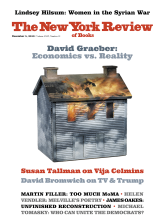In response to:
The Highest Suicide Rate in the World from the October 10, 2019 issue
To the Editors:
In “The Highest Suicide Rate in the World” [NYR, October 10], Helen Epstein concluded that “traditional Inuit society was remarkably peaceful and free of discord among them.” This is a mischaracterization of Inuit ethnography. Jean Briggs, whose monograph Never in Anger: Portrait of an Eskimo Family Epstein discussed at length, wrote:
Readers of Canadian Inuit ethnography, my own Never in Anger (1970) in particular, have sometimes concluded that Inuit are always and everywhere pacific. Nothing could be farther from the truth. Murder was known in many—perhaps all—Inuit societies, and in some it seems to have been a very frequent occurrence (e.g., Rasmussen 1932: 17). Feuding was an obligation in some societies (e.g., Oswalt 1967: 184–185; Spencer 1959: 71) and there were cases in which the community took it upon itself to dispose of a person who was widely feared; for example, a recidivist murderer or someone who was violently insane.
The first citation is to a monograph by the Danish-Inuit explorer and anthropologist Knud Rasmussen, who “once made an inspection of a small snow-hut camp of fifteen families, and found as a result that there was not a single grown man who had not been involved in a killing in some way or other.”
Still, this is consistent with a traditional ideology of goodwill and equanimity. As Briggs wrote, “I think the problem of conflict management is best phrased as a problem of keeping relations smooth; that is, keeping people happy, satisfied, unafraid, so that they will have no reason to be aggressive.”
Manvir Singh
Ph.D. Candidate
Harvard University
Cambridge, Massachusetts
Helen Epstein replies:
I thank Manvir Singh for this correction. He’s right. But it’s important to bear in mind that the violence of the past appears to have served as a kind of traditional law enforcement, directed at deviants who put the rest of the community at risk. For example, according to Kenn Harper’s Thou Shalt Do No Murder: Inuit, Injustice, and the Canadian Arctic (2017), the Inuit who killed the stranded and increasingly unstable fur trader Robert Janes did so because they feared his threatening and violent behavior. This is very different from the angry and often spontaneous violence against the self and others that afflicts many Inuit communities today.
This Issue
December 5, 2019
Against Economics
‘I Just Look, and Paint’
Megalo-MoMA



